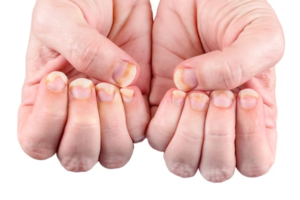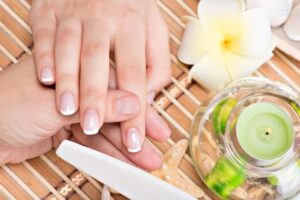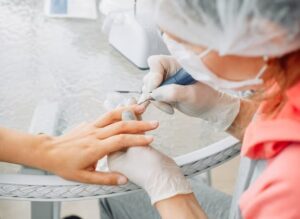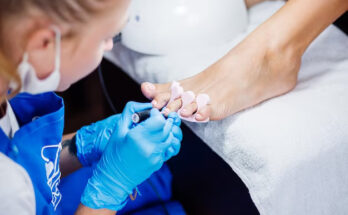When your nail grows into the skin on one or both sides for Fingernails, it becomes an ingrown nail. This may eventually result in discomfort, edoema, and possibly infection.
Many times, you can treat an ingrown fingernail at home by soaking the affected finger and using antibiotic ointment, but occasionally, you might need to consult a doctor.
What ingrown nails are, why they occur, how to cure them, and when to consult a doctor are all covered in this article.
What Is a Fingernail Ingrown?
Ingrown fingernails can also happen, which can be painful and make simple tasks like typing on a keyboard or holding a pen uncomfortable. Ingrown toenails are more prevalent than ingrown fingernails.

Normal conditions cause healthy nails to grow straight. You could get an ingrown fingernail if the nail plate starts to grow into the skin and curl downward. It may swell, hurt, and possibly get infected over time.
Ingrown fingernails may usually be treated at home, but it’s crucial to see a doctor if you start to feel extremely uncomfortable or see any symptoms of infection.
What Home Remedies Are Available for Ingrown Fingernails?
You can have an ingrown nail if you feel pain and observe that your nail is extending into the skin. You may take care of an ingrown nail at home unless you have diabetes, poor blood circulation in your hands, or an infection. For pain relief, you can also take Advil (ibuprofen) or Tylenol (acetaminophen).

Ingrown nail problems are more likely in those with diabetes or other disorders that limit blood flow. If they find an ingrown fingernail, they should be particularly careful with nail care and get help immediately once.
Why do ingrown nails occur?
When the side of your nail grows into the supple tissue supporting your toe or finger, it becomes an ingrown nail.
Ingrown nails can occur for a number of causes, including:
Ingrown nails are frequently the result of improper nail cutting. An ingrown nail is more likely to occur if the nail is cut too short or at an awkward angle.
Wearing uncomfortable or restricted shoes
Increased pressure on the nail may result from tight footwear. This can increase the chance of recurrence and cause nail fragments to grow deeply into the skin.
Repeated damage to the toenail:
Running and kicking are two sports-related actions that can cause ingrown nails.
Excessive perspiration:
Excessive perspiration might result in moist skin and nails. Softer nails could crack more frequently and penetrate the skin.
Treatments
How to care for an at-home ingrown fingernail
- Three to four times daily, use a warm compress or dunk your finger in warm water.
- For the remainder of the day, keep the finger dry.
- Apply an antibiotic cream.
- Grasp the nail with a little piece of damp cotton or dental floss.
Is it necessary to remove an ingrown fingernail?
No. A fingernail’s ingrown portion can become worse if it is cut or dug out. Instead, apply antibiotic ointment, keep the area dry, and bathe the ingrown fingernail in warm water.
Medical Treatments for Ingrown Fingernails
Your healthcare professional may suggest medical treatment if you don’t experience relief from your ingrown nail using home remedies. Although surgery is more frequently performed on ingrown toenails than on ingrown fingernails, both of these options may be used as treatments for ingrown fingernails.
Surgery
Ingrown nails are frequently treated by having them removed. It is a workplace technique that makes use of local anaesthesia. The nail is frequently just partially removed, but in extreme circumstances, your physician could have to cut it off completely.

Total nail removal is saved for more complex cases because the recuperation process could be uncomfortable. This is due to how delicate the tissue is behind the nail. In order to preserve as much of the nail as possible, only the side of the nail that has grown inward is removed during a partial removal. The nail will usually grow back after being removed in 6 to 12 months.
Chemical mutilation
The most effective ingrown nail treatment is partial nail avulsion, which eliminates the section of the nail that has penetrated the epidermis, in conjunction with chemical matricectomy.

Local anaesthesia is used to numb the infected area during the procedure, and the ingrown piece is then cut out. The nail bed is then treated with a chemical, such as phenol or sodium hydroxide. After applying antibiotic ointment, gauze is wrapped around the nail.
Antibiotics on Prescription
Antibiotics on prescription might be necessary if an infection is present. Additionally, your doctor could advise antibiotics for you to take following surgery.
Can a fingernail that has ingrown naturally?
Yes. Fingernail ingrowns typically get better on their own. It can heal more quickly if you soak your finger in warm water, apply antibiotic cream, and keep it dry.
Felons and Paronychians
An infection of the skin around a fingernail or toenail is known as paronychia. It can appear within hours and is marked by pain and inflammation. Additionally, yellow pus may form underneath the cuticle. Staphylococcus aureus (bacteria) penetrating a crack in the epidermis around the nails is a common cause of paronychia.
It can spread to other nail folds if it is not treated properly, which could result in chronic infection and long-term nail damage.
Deep inside the fingertip, there lies a deadly infection called a felon. It might result in an excruciating, pus-filled abscess. It frequently results from an infection with germs, most commonly Staphylococcus aureus bacterium.
Although Staphylococcus aureus bacteria are the main cause of both felon and paronychia, felon is frequently more painful and severe. Untreated paronychia can develop into a felon if it is allowed to grow and spread.
Ingrown fingernail causes
There may be no evident cause for ingrown fingernails. However, they frequently happen as a result of the nail being trimmed too short or not straight across, which causes the nail to grow directly into the skin rather than out.8 Additional causes of ingrown fingernails include:
- Regular hand washing
- Having fingernails that curve
- Genetic propensity
- A nail problem
- Having mani-pedis
- Missing nails
Tips for Avoiding Ingrown Nails
The key to avoiding uncomfortable ingrown fingernails is prevention. To avoid ingrown fingernails, keep your nails well-trimmed and wash them frequently.
Trimming Nails
It’s crucial to use a clean nail trimmer,
- cut your nails straight across the top without curving them.
- Don’t trim your nails too short.
- Tea tree oil can also be used to moisten your nails.
Tea tree oil’s antifungal and antibacterial qualities may be useful in the fight against nail fungus.
Summary
Ingrown nails are frequently the result of poor cutting, and they are easily treatable at home. The ingrown nail might cure more quickly by utilising antibiotic ointment and warm compresses on the affected area. Call your doctor, nevertheless, if you think you could have an infection.

















